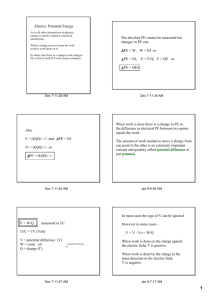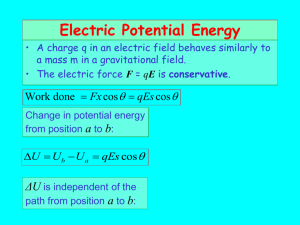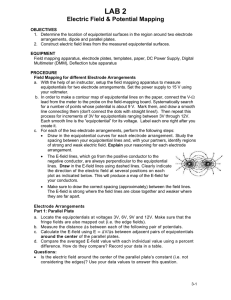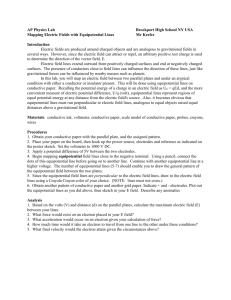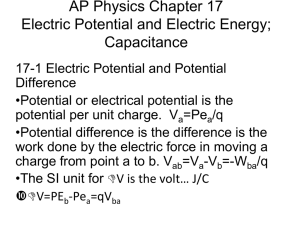Uniform Electric Field between Parallel Charged Plates Constant force on a charged particle
advertisement
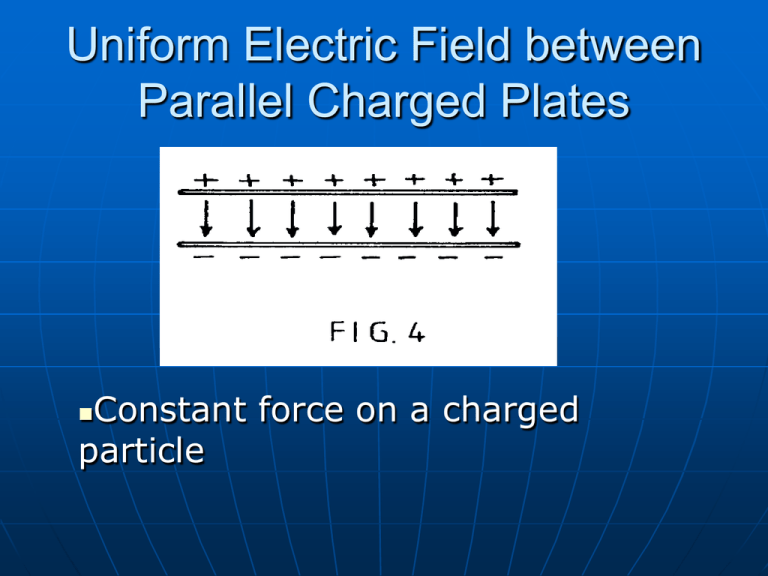
Uniform Electric Field between Parallel Charged Plates Constant force on a charged particle Example Determine the force on a proton between two parallel plates. (E=6 x 104 N/C, m=1.67x 10-27kg) Electric Potential Energy Potential of Electrostatic Force to Do Work Relate to Work done by External Force in Moving Charge Expressed in Terms of Electric Potential Difference Electric Potential and Potential Energy E F = qE +q d Work is done on the charge! (Potential) Energy of the objected increased by W = Fd = qEd = q V E E F = qE +q d F Electric Potential Difference V= E-field x distance [V] = N.m/C = J/C = Volt V Potential increases as moving against E-field. Work done to unit charge. 0 d E -q F = qE +q d Low potential A High potential B Potential energy for +q increases A -> B. However, potential energy for –q increases B -> A. Electric potential at B is higher than at A for both.. Energy and Charge Movements A positive charge gains electrical potential energy when it is moved in a direction opposite the electric field If a charge is released in the electric field, it experiences a force and accelerates, gaining kinetic energy • As it gains kinetic energy, it loses an equal amount of electrical potential energy A negative charge loses electrical potential energy when it moves in the direction opposite the electric field Energy and Charge Movements, cont When the electric field is directed downward, point B is at a lower potential than point A A positive charge that moves from A to B loses electric potential energy It will gain the same amount of kinetic energy as it loses potential energy Summary of Positive Charge Movements and Energy When a positive charge is placed in an electric field • It moves in the direction of the field • It moves from a point of higher potential to a point of lower potential • Its electrical potential energy decreases • Its kinetic energy increases Summary of Negative Charge Movements and Energy When a negative charge is placed in an electric field • It moves opposite to the direction of the field • It moves from a point of lower potential to a point of higher potential • Its electrical potential energy decreases • Its kinetic energy increases E a d a +q How much of work has been done on the charge? W = qE dcos(a) Electric potential changed by V = E d cos(a). Important!! Motion perpendicular to E-field does not change potential. Equipotential Line v v v v + + + + + + + + + + + + Surface of conductor ll Equipotential surface Equipotential Surfaces An equipotential surface is a surface on which all points are at the same potential • No work is required to move a charge at a constant speed on an equipotential surface • The electric field at every point on an equipotential surface is perpendicular to the surface Two parallel conducting plates are charged as shown in the figure. An electron is injected between the plates from the left side (see figure). Which curve describes the trajectory of the electron correctly? + - v 1. 2. 3. 4. - A B C D + A - + - + - + - + - + - + - - B C D Comparison with GRAVITY Gravitational (on the earth) Electric Mass, m (Kg) Only 1 type g (m/s2=N/Kg) Charge, Q (C) + and E-field (N/C) mgh (Nm = J) QEd (J) Potential enery Potential energy gh (Nm/Kg) Ed (Nm/C) Gravitational potential Electric potential Prob. 27 E = 3500 N/C Q * 70 cm = 0.7 m 1.Is Q positive or negative? 2.How large force would a +1 C charge experience at *? 3.What is Q value? A2. Electric field: force on a positive unit charge FE = qE. FE = (+1 C)(3500 N/C) = 3500 N A3. FE = qE = k|Q|.|q|/r2 3500 N = (8.99x109 Nm2/C2) (Q C)(+1 C)/(0.7 m)2 Q = -1.9x10-7 (C) negatively charged -Q - - - - - - - - V=e - e +Q Q Q=C e e Capacitanc e The Electron Volt The electron volt (eV) is defined as the energy that an electron (or proton) gains when accelerated through a potential difference of 1 V • Electrons in normal atoms have energies of 10’s of eV • Excited electrons have energies of 1000’s of eV • High energy gamma rays have energies of millions of eV 1 eV = 1.6 x 10-19 J Example Car battery (12V) Work done to move a proton from A to B Work done to move an electron from A to B
